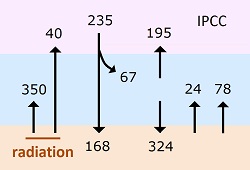Climatologists pretend to have measured an increase in average ocean temperatures of 0.2°C over the past several decades. The heterogeneity of the oceans is so extreme and rapidly changing that the trivial measurements tell nothing. A single measurement doesn't say whether it represents five feet of water of five hundred miles of water. The temperatures can vary by several degrees in a few feet. The ARGO measuring buoys have 351 km (218 miles) of average space between them.
Any temperature could be due to any number of unknown effects other than humans putting carbon dioxide into the air. Evaporation removes much more heat from the oceans than the miniscule quantities supposedly being measured. But the heat gets replaced by the sun, which too occurs in huge quantities compared to the miniscule effects claimed for carbon dioxide influences in the air.
The sun is said to add 168 watts per square meter to the earth including oceans, while the claimed temperature increase for the oceans due to carbon dioxide in the air is said to be added through 0.27 w/m² (published article). That's a ratio of 622 to 1. Most of the sun's energy leaves through evaporation, but some stays in the ocean. How much is impossible to guess.
Between ice ages, solar heat slowly accumulates in the oceans. The average increase is imperceptibly slow, while 168 w/m² from the sun is going into and out of the oceans constantly. The amount equilibrates, which means it stabilizes with all interacting forces. If 168 w/m² is equilibrating, why is 0.27 w/m² accumulating and showing a short-term increase of 0.2°C? Any such effect would equilibrate to zero short-term effect along with the other 168 w/m². In other words, if 168 w/m² is going to exit the oceans to equilibrate, 168.27 w/m² is going to exit for the same reasons.
According to climatologists, there is a lot more radiation than 168 w/m² going into the oceans. They have huge amounts of radiation going into the oceans from the atmosphere and radiating back out. They use extreme amounts of radiation, because it is necessary for contriving a greenhouse effect. This image shows the numbers they use.

They have an additional 324 w/m² radiating from atmosphere to earth including oceans (which are 71% of the surface area of the earth) and 390 w/m² radiating back out, with only 78 w/m² leaving by evaporation and 24 w/m² leaving by conduction. It's 0.05% of the energy staying in the oceans and adding heat, while 99.95% exits the oceans (0.27÷168+324=0.0005). That's a noise to signal ratio of 1,822 to one.
In actuality, there is almost no radiation emitted by the cold, average surface temperature of the earth, said to be 15°C (59°F). I estimate that 1% of the energy leaving the surface of the earth is in the form of radiation, with the rest being conduction and evaporation. (See White Hot Metals.)
Climatologists don't determine the 0.27 w/m² in a direct manner; they claim to measure the temperature increase of the oceans and then calculate how much radiation would be required to produce that much heat when accumulating over 40 years. How come the 168 w/m² of energy which the sun puts into the oceans comes back out with no detectable amount staying in, while the 0.27 w/m² of energy which the humans put into the oceans stays there and accumulates for 40 years with not an iota coming back out? Logic is sacrificed to contrivance in Climatology.
The primary absurdity is that determining an average temperature of the oceans, repeated over the past 40 years, is totally impossible. The oceans are extremely heterogeneous, with rivers of motion and mountains of hot and cold temperatures.
A few years ago, a project called ARGO used 3,000 diving buoys to measure temperatures over the top 700 meters of the oceans. That's 351 kilometers of space between each one on average (3.7x108÷3,000=123,000km², x½=351km). There is an infinite amount of variation every 351 km in the oceans, and it changes constantly.
The mentality throughout climatology and physics is that if you collect enough nonsensical data points for any question they will average out to a representative average. The implication of that assumption is that infinite measurements are made over the domain in question. Yet physicists/climatologists can only measure miniscule fractions of the variations that occur. The error is in assuming that a miniscule number of measurements will produce the same average as an infinite number of measurements.
Climatologists get a huge amount of random error in their miniscule measurements—so much so that they can't get anything close to an actual number for temperature of the oceans, and hence for global average surface temperatures. The claimed measurements are contrived by starting at desired end points and faking a method of getting there.